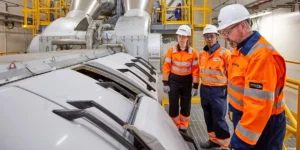EXCLUSIVE | ‘Green hydrogen producers in line for tens of millions of euros a year from EU carbon market’

European green hydrogen producers could be in line to receive tens of millions of euros per year in free allowances under the EU’s carbon trading mechanism, analysts tell Hydrogen Insight.
Earlier this month, the EU finalised rules that allow producers of green steel — which use clean production methods such as hydrogen-based direct-reduced iron (H2-DRI) and electric arc furnaces — and green hydrogen to claim and sell free allowances under the Emissions Trading System (ETS).
According to Norwegian data analytics house Veyt, the value of free allocations to a green hydrogen producer able to produce 50,000 tonnes of green H2 per year (equivalent to roughly 500MW of electrolysis capacity) would be €37m ($39m) per year by 2027, based on Veyt’s carbon allowance price forecasts.
But after 2027, revenue for green hydrogen producers from carbon credits would fall as the EU’s phase-out of free allowances (which starts in 2026) begins to take hold.
By 2030, a green hydrogen producer with a plant of that size could be expected to earn around €22.5m (based on real 2024 prices and not adjusted for inflation), Veyt analysts Abhinav Bhaskar and Henry Lush tell Hydrogen Insight.
“These benefits will last until 2030 and are going to fluctuate based on the emission price,” the analysts say. “This can be thought of as a green premium to reduce the gap between the grey and green hydrogen prices.”
Article continues below the advert
The extra revenue could provide a significant bolster to the short-term business case for green hydrogen producers, and manufacturers of green steel.
German steel producer Stahl-Holding-Saar (SHS) recently launched a tender for 50,000 tonnes of green hydrogen by 2030 to help fuel (alongside fossil gas) its new DRI unit in Dillingen, as part of a green steel initiative that envisages using both H2-DRI and scrap metal.
However, there are as yet no pure-play green hydrogen projects in Europe of 500MW or more of capacity that have reached a final investment decision (FID) — meaning that no single producer would be set to receive this level of revenue from carbon credits at present.
Even so, there are a number of larger-scale projects targeting near-term production. For example, Spain’s Cepsa is targeting 2GW of electrolysis capacity across two Spanish sites by 2028.
And Shell’s 200MW Holland Hydrogen 1 offshore wind-to-green-H2 project in the Netherlands is targeting the start of production in 2025 .
The new ETS rules are intended to level the playing field with steel producers that use highly polluting coal, which are already allocated free allowances to incentivise them to keep production capacity in Europe, rather than relocating to regions with lax carbon regulations.
But with the introduction of the Carbon Border Adjustment Mechanism (CBAM) in earnest in 2026, the free allowances are due to be phased out, with the scheme coming to a close in 2034.
This is because the CBAM will impose carbon taxes on imports of a wide variety of industrial products such as hydrogen, ammonia and steel, into European markets, effectively levelling the playing field between European producers and their foreign competitors.






